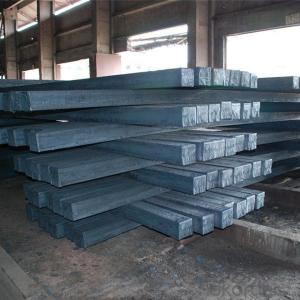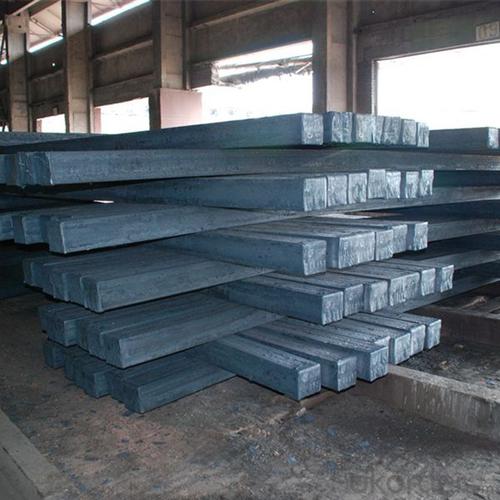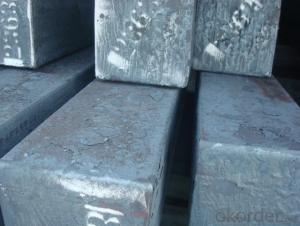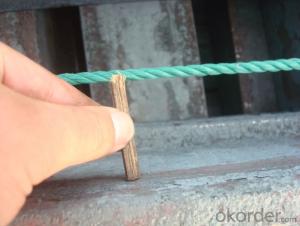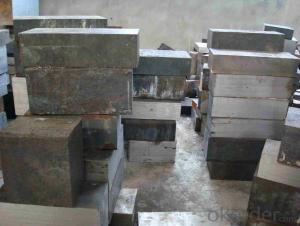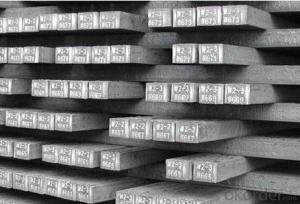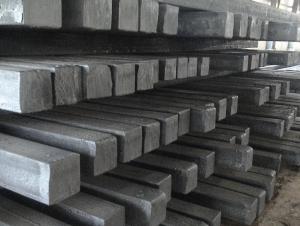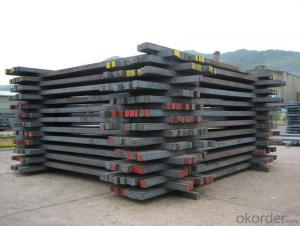Hot Rolled steel products material Square Bar Steel Billet For Sale 60*60,90*90,100*100,120*120mm
- Loading Port:
- China main port
- Payment Terms:
- TT OR LC
- Min Order Qty:
- 25 m.t.
- Supply Capability:
- 8000000 m.t./month
OKorder Service Pledge
Quality Product, Order Online Tracking, Timely Delivery
OKorder Financial Service
Credit Rating, Credit Services, Credit Purchasing
You Might Also Like
Quick Details
| Place of Origin: | Hebei, China (Mainland) | Model Number: | Hot Rolled Square Bar Steel Billet For Sale 60*60,90*90,100*100,120*12 | Grade: | 3SP,5SP,Q195,Q235,20MnSi |
| Chemical Composition: | C,Mn,Ni,Si,P,S,Cr,Cu | Shape: | Square | Length: | 6m,9m,12m |
| Standard: | ASTM | Technique: | Hot Rolled | Dimensions: | 60*60,90*90,100*100,120*120mm |
| Alloy Or Not: | Is Alloy | Secondary Or Not: | Non-secondary | process: | hot rolled |
| material: | Q195,Q235,3SP,5SP | specification: | 60*60,90*90,100*100,120*120mm | length: | 6m,12m |
| type: | low carbon,high carbon | supply ability: | 200,000mts/month | Alloy or not: | Alloy |
| application: | the steel products material | shape: | square | MOQ: | 100mts/each size |
Packaging & Delivery
| Packaging Details: | bude bundle packing |
| Delivery Detail: | within 15-25 days after the prepayment or L/C we received |
Specifications
A.mateiral:Q235B,3/5SP,20MnSi
B.length:6m,9m,12m
C.size:60*60,90*90,100*100,120*120mm
D.supply ability:200,000mts/month
Product Description
Chemical Composition: Carbon
Shape: Square
Length: 6M 9M 12M
Standard: GB
Technique: Hot Rolled
Dimensions: 60*60-130*130mm
Alloy Or Not: Non-alloy
Secondary Or Not: Non-secondary
Packaging & Delivery:
Packaging Detail: In standard packing
Delivery Detail: In 25-30 days
Our advantage:
Guaranteed quality
All specifications available
Goods in stock
Customizable according to order
Credit sales acceptable
Customizing service:
Sizes, length, width, thickness, surface, all of these can be customized according to order.
After service
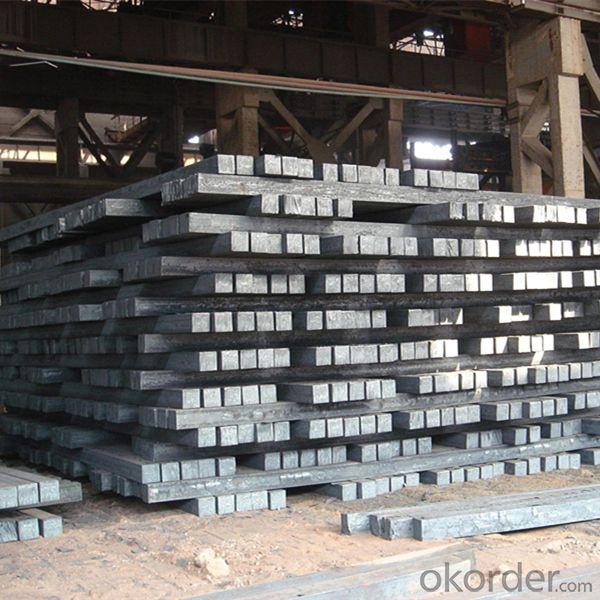
- Q: What are the different quality control measures for steel billets?
- To ensure the high quality of steel billets, several quality control measures are implemented during their production and inspection. These measures encompass: 1. Thoroughly analyzing the chemical composition of steel billets to ensure it aligns with the required specifications. This analysis involves determining the content of elements like carbon, manganese, sulfur, phosphorus, and others. Any deviations from the specified composition can impact the mechanical properties of the billets. 2. Verifying the size, shape, and weight of steel billets through dimensional inspection. This entails measuring the length, width, and thickness of the billets using precision instruments and ensuring they meet the specified tolerances. Any deviations from the required dimensions can affect the billets' performance during subsequent processing. 3. Inspecting the surface of steel billets for defects or irregularities. This includes checking for cracks, surface discontinuities, surface roughness, and other imperfections. Surface inspection is typically conducted using visual inspection techniques or non-destructive testing methods like magnetic particle testing or ultrasonic testing. 4. Conducting mechanical testing to assess the mechanical properties of steel billets. This involves tests such as tensile testing, hardness testing, and impact testing to determine the billets' strength, ductility, toughness, and other mechanical characteristics. These tests ensure that the billets possess the required mechanical properties for their intended applications. 5. Examining the microstructure of steel billets through metallurgical examination. This helps identify any defects in the metal structure, such as grain size, segregation, inclusions, or improper heat treatment. By assessing the metallurgical properties, the quality control team can ensure that the billets are free from any internal defects that might compromise their structural integrity. 6. Using non-destructive testing techniques like ultrasonic testing, magnetic particle testing, or eddy current testing to detect internal defects or discontinuities that may not be visible through visual inspection. These methods allow for the detection of flaws without damaging the billets, ensuring their integrity is maintained. 7. Maintaining proper documentation and traceability throughout the production process. This involves documenting the results of all inspections, tests, and analyses performed on the steel billets, as well as tracking their origin, processing history, and any relevant certifications. This documentation ensures transparency and enables traceability in case of any quality-related issues. By implementing these quality control measures, steel manufacturers can ensure that the produced billets meet the required specifications, possess the desired properties, and are of high quality. This enhances their reliability and suitability for various applications in industries such as construction, automotive, and manufacturing.
- Q: How are steel billets different from steel ingots?
- Steel billets and steel ingots are both semi-finished steel products, but they differ in terms of their shape, size, and manufacturing process. Firstly, the shape of steel billets and steel ingots is different. Steel billets are typically square or rectangular in shape, with specific dimensions that are determined by the production requirements. On the other hand, steel ingots have a more irregular shape, often resembling a large block or loaf. The shape of the ingot is determined by the mold in which it is cast. Secondly, the size of steel billets and steel ingots also varies. Steel billets are generally smaller in size compared to ingots. Billets are typically produced in smaller cross-sectional areas and lengths, making them more suitable for further processing. Steel ingots, on the other hand, are larger and heavier, as they are cast in molds that can accommodate a greater volume of molten steel. Lastly, the manufacturing process for steel billets and steel ingots differs. Steel billets are typically produced through a process called continuous casting, where molten steel is poured into a water-cooled mold to solidify into the desired shape. This process allows for a more controlled and efficient production of billets. On the other hand, steel ingots are generally produced through casting in open or closed molds, where the molten steel is poured and left to solidify. This process is often slower and less precise compared to continuous casting. In summary, steel billets and steel ingots differ in terms of their shape, size, and manufacturing process. Billets are square or rectangular in shape, smaller in size, and produced through continuous casting, while ingots have an irregular shape, larger in size, and produced through casting in molds. Both products serve as essential raw materials for the production of various steel products.
- Q: Can steel billets be used in the production of kitchenware?
- Yes, steel billets can be used in the production of kitchenware. Steel billets can be further processed and shaped into various kitchenware items such as pots, pans, knives, utensils, and cookware. The malleability and durability of steel make it a suitable material for kitchenware production, providing strength, heat resistance, and longevity to the finished products.
- Q: What are the main factors affecting the corrosion resistance of carbon steel billets?
- The main factors affecting the corrosion resistance of carbon steel billets are the composition of the steel, the presence of impurities or alloying elements, the surface condition and finish, the environment (including humidity, temperature, and exposure to corrosive agents), and the protective coatings or treatments applied to the billets.
- Q: What is the role of steel billets in the manufacturing of industrial boilers?
- Steel billets play a crucial role in the manufacturing of industrial boilers. These billets serve as the raw material from which the various components of the boiler are formed. Industrial boilers are complex structures that require high-quality, durable materials to withstand the harsh conditions they operate in. Steel billets are typically made from carbon steel or alloy steel, which possess excellent strength and corrosion resistance properties. These billets are first heated and then shaped into different forms, such as plates, tubes, or rods, through processes like rolling, extrusion, or forging. These formed components are then further processed and assembled to create the boiler. In the manufacturing process, steel billets are used to fabricate important boiler components, such as the shell, tubes, and flues. The shell, made from steel plates, provides the main body of the boiler, while the tubes and flues allow for the passage of hot gases and water. Steel billets ensure the structural integrity of these components, as they can withstand high temperatures and pressures without deforming or failing. Moreover, steel billets are also used to create other auxiliary components of industrial boilers, including supports, brackets, and fittings. These components are crucial for the proper functioning and installation of the boiler, ensuring stability, efficiency, and safety. Overall, steel billets are essential in the manufacturing of industrial boilers as they provide the necessary strength, durability, and versatility required to withstand the demanding conditions of operation. The use of high-quality steel billets ensures that the boilers are reliable, long-lasting, and capable of meeting the rigorous performance standards expected in industrial applications.
- Q: How do steel billets contribute to the manufacturing of industrial equipment?
- Steel billets are a crucial raw material in the manufacturing of industrial equipment as they serve as the starting point for various metal fabrication processes. These billets are heated, shaped, and further processed to create components such as gears, shafts, plates, and frames that form the backbone of industrial machinery. Their high strength, durability, and versatility make steel billets an essential ingredient in producing robust and reliable equipment for industries ranging from construction and mining to automotive and energy.
- Q: What are the different types of cutting methods used for steel billets?
- There are several different types of cutting methods used for steel billets, including sawing, shearing, flame cutting, and water jet cutting.
- Q: Are steel billets subject to any regulations or certifications?
- Yes, steel billets are subject to various regulations and certifications. The regulations and certifications ensure that the production, quality, and safety standards of steel billets are met. One of the most common certifications for steel billets is the ISO 9001 certification, which is an international standard that sets out the criteria for a quality management system. This certification ensures that the manufacturing process of steel billets follows consistent quality control measures, from raw material sourcing to final production. Additionally, steel billets can also be subject to specific industry certifications, depending on their intended use. For example, if the steel billets are intended for use in construction projects, they may need to comply with certifications such as ASTM (American Society for Testing and Materials) standards or the European EN (European Norm) standards. These certifications define the required mechanical properties, chemical composition, and other specifications that steel billets must meet to ensure their suitability for construction purposes. Furthermore, steel billets may also be subject to regulations imposed by governmental bodies or industry associations. These regulations can include safety standards, environmental regulations, and compliance with trade policies. For instance, steel billet producers may need to comply with regulations regarding emissions, waste management, or occupational health and safety. In summary, steel billets are subject to various regulations and certifications to ensure their quality, safety, and compliance with industry standards. These certifications and regulations play a vital role in maintaining the integrity of steel billets and ensuring their suitability for various applications.
- Q: What are the different types of steel billet surface defects?
- During the manufacturing process, various steel billet surface defects may arise. These defects have the potential to impact the steel's quality and performance, thus necessitating their identification and resolution to safeguard the final product's integrity. 1. Scale: Oxidation during heating and rolling gives rise to a widespread defect known as scale. This defect manifests as a thin layer of iron oxide on the billet's surface, which can be readily eliminated through descaling procedures. 2. Cracks: Another common defect is cracks, which can emerge on the billet's surface. These cracks can be caused by factors such as uneven cooling, excessive stress, or improper handling. Due to their ability to compromise structural integrity, cracked billets necessitate repair or disposal. 3. Pitting: Pitting is characterized by shallow depressions or pits on the billet's surface. It can arise due to impurities in the steel, inadequate cooling, or corrosion. Pitting diminishes strength and heightens susceptibility to corrosion. 4. Lamination: Lamination defects occur when the billet experiences poor bonding during manufacturing, leading to the presence of layers or separation. This defect undermines the steel's mechanical properties, potentially resulting in failure under stress. 5. Inclusions: Non-metallic substances, such as slag, oxides, or other impurities, can become trapped within the billet during manufacturing, causing inclusions. Inclusions weaken the steel and decrease its ductility, rendering it more prone to cracking or breaking. 6. Scratches: Superficial defects like scratches may arise during billet handling or transportation. While they may not significantly impact overall structural integrity, they can concentrate stress in localized areas, potentially leading to failure in specific applications. 7. Decarburization: Decarburization occurs when the billet's surface loses its carbon content during the heating process. This defect reduces hardness and strength in the affected region, impacting the steel's performance. Manufacturers and inspectors must possess knowledge of these various steel billet surface defects to ensure the production of high-quality steel products. Regular inspections, quality control measures, and appropriate corrective actions are vital in minimizing and addressing these defects, thereby guaranteeing the desired steel performance and longevity.
- Q: What is the average production cost of steel billets?
- The average production cost of steel billets can vary depending on various factors such as raw material prices, energy costs, labor expenses, and market conditions. It is best to consult industry reports or reach out to steel manufacturers for the most accurate and up-to-date information on the average production cost of steel billets.
Send your message to us
Hot Rolled steel products material Square Bar Steel Billet For Sale 60*60,90*90,100*100,120*120mm
- Loading Port:
- China main port
- Payment Terms:
- TT OR LC
- Min Order Qty:
- 25 m.t.
- Supply Capability:
- 8000000 m.t./month
OKorder Service Pledge
Quality Product, Order Online Tracking, Timely Delivery
OKorder Financial Service
Credit Rating, Credit Services, Credit Purchasing
Similar products
Hot products
Hot Searches
Related keywords
